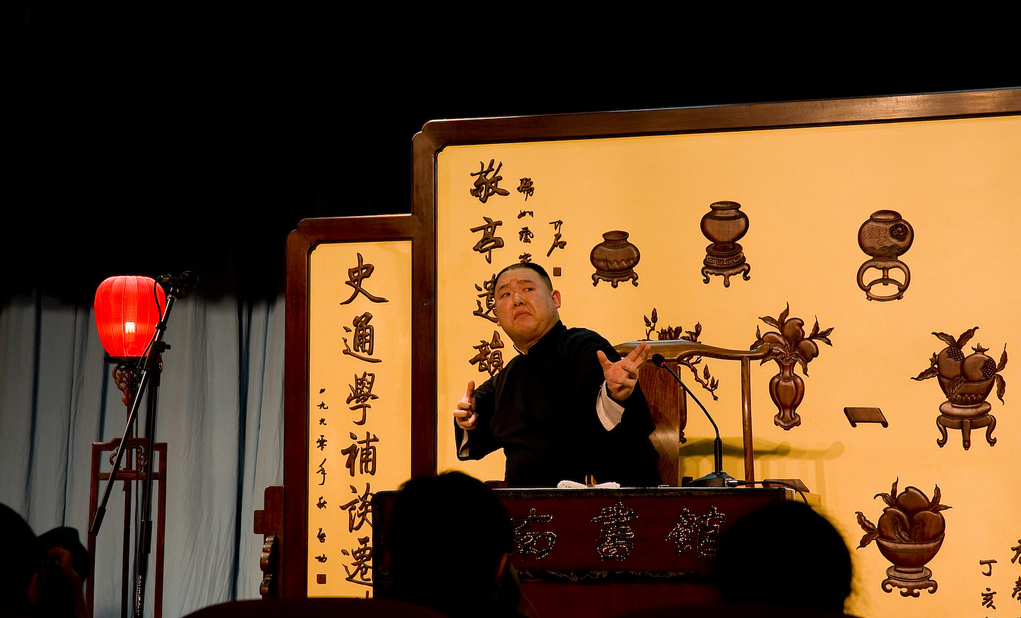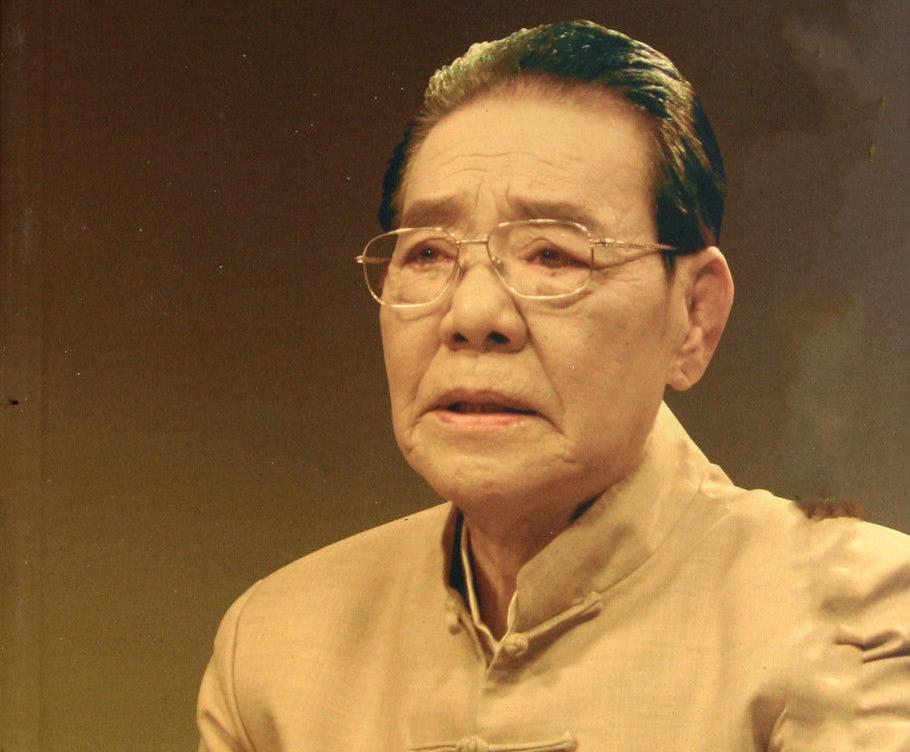China has a long-standing tradition of performing arts, with generations of artists being trained up (often by their fathers or other male relatives) to follow in the footsteps of their predecessors in their chosen artform. Three of these artforms thus passed on in China are crosstalk (相声 in Mandarin, xiàngsheng in pinyin), storytelling (评书 in Mandarin, píngshū in piyin), and drama (话剧 in Mandarin, huàjù in pinyin).
Each of those art forms lost a notable performer this month. So, let’s take the sad passing of Chang Baohua (常宝华 in Mandarin), Shan Tianfang (单田芳 in Mandarin) and Zhu Xu (朱旭 in Mandarin) as an occasion for taking a closer look at the art they performed.
The Art of Crosstalk
Xiangsheng (or crosstalk in English) is a traditional comedic performing art form that holds an important place in Chinese popular culture. Usually, it involves a humorous dialog between two performers – though there are instances when it uses the monologue form or even multiple performers performing in a group.
Xiangsheng is quick-paced, full of banter, puns and allusions, and most often performed in the Beijing dialect. Some performers deviate from that by delivering their lines in Mandarin, but with a strong northern accent. Most often, there is only speech, but some acts also include singing, Chinese “rap” (快板 in Chinese, kuàibǎn in pinyin) or can be accompanied by musical instruments.

Crosstalk started as a street performance art form, most likely in the late Qing Dynasty, though some scholars believe its roots to go as far back as the late Ming Dynasty. Later, it moved from the streets into teahouses and small theaters, and – eventually – into radio and TV when these media became more popular in China. Crosstalk has always acted as a social commentary, and though there are some “classic xiangsheng” pieces well over 100 years old, they have been updated and revised numerous times to keep them culturally relevant.
Maybe the most famous xiangsheng performer in China was Hou Baolin. He was instrumental in reforming crosstalk in the 1950s and turned it from lowly street performances into a well-respected art form.
Chang Baohua
September 2018 saw the loss of a notable xiangsheng performer. Chang Baohua was part of the 6th generation of crosstalk actors in his family. Born into a poor family in Tianjin (while xiangsheng is a popular art form, it doesn’t always pay enormous amounts of money to perform it), he learned the art from his father and older brother.

Chang performed crosstalk for the first time on stage when he was just 9 years old, and authored over 170 xiangsheng works, as well as teaching the art at Peking University and in crosstalk training courses. Chang also promoted the art of xiangsheng through lectures and performances in the US, Russia, Poland, Austria, Switzerland, Korea, and Singapore.
Chang Baohua died in Beijing on September 7th, 2018. At his funeral on September 11th, 2018, many fellow xiangsheng performers, as well as other celebrities, bid farewell to this outstanding artist.
The Art of Storytelling
Pingshu (评书 in Mandarin, píngshū in pinyin), or storytelling in English, is a popular form of entertainment in China. This art form consists of performers retelling stories – sometimes taken from Chinese history, sometimes from popular works of fiction – with exaggerated sound-effects, different voices for the different characters, and sometimes additional commentary. At first, pingshu was only performed on stage, often with a fan and/or a gavel to add sound effects. Lateron, the preferred medium for pingshu was radio broadcasts.

The artform gained momentum in the 1980s, when bigger and bigger parts of the Chinese population owned radios. People would meet up and listen to the storytellers together, even farmers would take a radio into the fields with them in order not to miss the next installment of the story. Nowadays, people have access to the entire series (i.e. the entire story) via downloading, but many put them on their phones, to entertain them when they wait somewhere, on their commute, or even on their walks through the park.
If you regularly take cabs in Northern China, I can virtually guarantee that you have experiencedpingshu before. Many taxi drivers in Shenyang listen to the recordings of notable pingshu artists during work time.
Many pingshu artists have a very distinct style of delivering the stories. So, even if your Chinese is not the best (or even basically non-existent), you should be able to distinguish storytelling from different sources.
Shan Tianfang
Thepingshu I’ve heard most often in cabs here in Shenyang are actually the stories told by Shan Tianfang (单田芳 in Chinese). His deep, raspy voice and wonderful way of giving each character their own distinct personality are unmistakable. Sadly, he is another one of the artists who have left us forever this month, as he died on September 11th, 2018, at 84 years of age.
Shan Tianfang, which is actually his stage name, as he was born Shan Chuanzhong (单传忠 in Chinese), hailed from Yingkou, a port city not far from Shenyang. His family held several generations of opera artists, but young Shan entered Northeastern Engineering College. When his father was wrongly sent to prison and his mother divorced her husband, Shan left school to support the family. He started earning money by performingpingshu on stage, both traditional and original pieces.

Over his long career, Shan Tianfang recorded over 100 different works in his own, oft-imitated but rarely matched style. Several generations of Chinese were deeply touched by his storytelling genius.
The Art of Modern Chinese Drama
The third art form that lost a renowned performer this month is modern Chinese drama. Traditionally, Chinese theater focused on Beijing Opera (or other local variants thereof), classical Chinese drama, shadow play, xiangsheng, and others. But drama as it is performed in the West (mostly focusing on unaccompanied dialog), only came to Chinain the beginning of the 20th century. While this artform saw a noticeable decline in recent decades, famous stage actors are still well-respected in the Chinese art scene.

Zhu Xu
Zhu Xu, a born and bred Shenyanger, was a popular performing artist at Beijing’s People’s Art Theater. When Zhu Xu passed away this month, on September 15th, he was 88 years old.
A drama student of North China University, Zhu worked as an actor in the university drama troupe after graduation. At only 22 years of age, however, he joined the Beijing People’s Art Theater, where his career would keep him for 60 years. Actually, his last performance before he retired was in the drama “Jiazi Yuan”, a play to celebrate Beijing People’s Art Theater’s 60th anniversary.

In addition to his work on stage, Mr. Zhu also appeared in a great number of films, especially in his later years.
These three great Chinese artists will be remembered for the dedication they showed to their craft. Studying their works is a perfect way of gaining a deeper insight into Chinese culture. Had you heard of any of them? Or maybe even seen or heard some of their work? Let me know in the comments!


